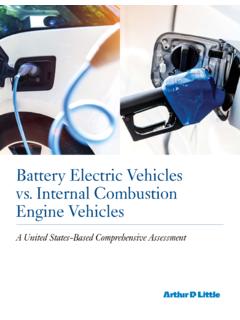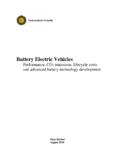Transcription of Battery Electric Vehicles vs. Internal Combustion …
1 Battery Electric Vehicles vs. Internal Combustion engine Vehicles A United States-Based Comprehensive Assessment Contents Executive Summary 1. Summary of Findings 4. Introduction to BEVs 5. Economic Assessment: Total Cost of Ownership 7. Total Cost of Ownership and True vehicle Cost 8. Environmental Assessment: Global Warming Potential 11. Environmental Assessment: Secondary Environmental Impacts 14. Alternative Views 16. Technology Forecast: BEVs and ICEVs in 2025 21. Conclusion 25. References 26. Appendices 28. Authors: John W. Brennan Timothy E. Barder, Managing Director, Arthur D. Little, Manager, Arthur D. Little, Strategy & Organization, Boston Strategy & Organization, Boston The authors acknowledge Hui Zhao, Tom Parish, Brian St.
2 Amand, and Mike Gourd for their assistance in preparing this report. Battery Electric Vehicles vs. Internal Combustion engine Vehicles Executive Summary A United States-Based Comprehensive leveraged this information to model the 2025 TCO, GWP, and Secondary Environmental Impacts for BEVs and ICEVs. Assessment Based on our study, the ultimate environmental and economic Battery Electric Vehicles (BEVs) do not consume gasoline or reality of Electric Vehicles is far more complicated than their produce tailpipe carbon emissions, placing the promise of an promise. From an economic perspective, BEVs enjoy some distinct environmentally sustainable driving experience within reach of the advantages. First, the electricity cost associated with operating a average consumer.
3 However, the question remains: Do BEVs BEV over a distance of one mile is significantly lower than the truly offer an environmental advantage with respect to global gasoline cost required to operate a comparable ICEV over the same warming potential and secondary environmental impacts and if distance. Second, BEVs cost less to maintain, owing to the relative so, at what cost? . elegance and simplicity of a Battery - Electric motor system To address this question, Arthur D. Little conducted a total lifecycle compared with the frequent maintenance required for operation of economic cost and environmental impact analysis of Lithium-ion an Internal Combustion system. Third, automotive Battery Battery Electric Vehicles (BEVs) versus Internal Combustion engine technology has evolved rapidly since the current generation of BEVs Vehicles (ICEVs) to further understand BEVs and their transforma- came to market, with the price per kilowatt-hour (kWh) of tive potential.
4 This study models the relative impacts of new BEVs lithium-ion Battery packs declining from $1,126 in 2010 to just $300. and ICEVs in the United States for the latest full calendar year for in 2015 (see Appendix E-1). which data is available, 2015, and it projects the economic and These cost advantages, however, are entirely offset by a host of environmental impacts of BEVs and ICEVs over the entire assumed other economic factors. The TCO for a BEV is significantly greater twenty-year lifetime for a US passenger vehicle . Given that this is a than the TCO for an equivalent ICEV. BEVs in 2015 were, without rapidly evolving market, our study also forecasts the economic and exception, significantly more expensive to manufacture than environmental impacts that new BEVs and ICEVs will have in 2025, comparable ICEVs due primarily to the cost of Battery taking into account salient expected developments in Battery manufacturing and they imposed a much higher cost burden on technology, vehicle range, and fuel economy standards.
5 vehicle owners (see Figure 1). Ultimately, this cost burden presents In order to determine the true cost and environmental impacts from BEVs, we performed a comprehensive quantitative analysis Figure 1. Total Cost of Ownership over a 20-Year Lifetime for excluding any government incentives or subsidies. Our study a 2015 ICEV versus an Equivalent BEV. investigated every stage of the vehicle 's lifecycle , from R&D and In Thousands of Dollars at Present Value production, including sourcing of raw materials, through ownership and end-of-life disposal. We evaluated the impacts associated with 100. 86. each component of the vehicle , from the novel technologies and 80. 68 +60%. chemistries involved in Battery production to the In-Use energy +44%.
6 60 54. requirements ( , gasoline and electricity, from well-to-wheels) 48. 40. necessary to power a vehicle . We constructed models that calculate the 2015 Total Cost of Ownership (TCO), Global Warming 20. Potential (GWP), and Secondary Environmental Impacts ( , 0. Human Toxicity Potential characterized as Disability Adjusted Life Compact Compact Mid-Size Mid-Size Years lost) for BEVs and ICEVs. We also forecast how BEV and ICEV BEV ICEV BEV. ICEV technology will evolve over the coming decade and we Source: ADL Analysis 1. Battery Electric Vehicles vs. Internal Combustion engine Vehicles Figure 2. Greenhouse Gas Emissions over a 20-Year Lifetime Figure 3. Days of Life Impact (Death or Disability) for a 2015.
7 For a 2015 ICEV versus an Equivalent BEV Compact Passenger ICEV versus an Equivalent BEV over 20. In Thousands of Pounds of CO2e Emissions Years of Ownership 160 152 ICEV BEV. 137 -19%. Production and R&D 4 9. -23% 123. 120. 105. Replacement Battery 5. 80. In-Use 2 4. 40 Alternative Transport 1. End of Life 0 0. 0. Compact Compact Mid-Size Mid-Size Total 6 20. ICEV BEV ICEV BEV. Values do not sum to total due to rounding. Source: ADL Analysis Source: ADL Analysis a significant barrier for wider adoption of BEVs and could explain dispersed and damaging set of environmental impacts, offsetting why their market penetration has been limited to date. a significant portion of their overall advantage with respect to greenhouse gas emissions.
8 From an environmental perspective, the picture is even more complex. BEVs in 2015 achieve the goal of reducing greenhouse In particular, the usage of heavy metals in the manufacture of gas emissions relative to comparable ICEVs when considered lithium-ion Battery packs for BEVs combined with pollution over a vehicle 's lifetime, but this masks an increased human generated by the US power grid ( tailings from coal power health impact relative to ICEVs and a host of other collateral plants) for the In-Use portion of a BEVs lifecycle generate approxi- impacts to the environment (see Figures 2 and 3). While most of mately three times the amount of human toxicity compared to the environmental impacts generated by ICEVs are localized to ICEVs (see Figure 3).
9 Given the divergence in where environmental the Combustion of gasoline in the vehicle engine , the impacts are allocated, it is safe to say that a consumer who manufacturing process for BEVs generates a much more widely- chooses to drive a BEV over an ICEV shifts the environmental Figure 4. Comparison of ADL's Study with Union of Concerned Scientists' and National Bureau of Economic Research's Findings Impact Area ADL UCS NBER. Total Cost of Ownership BEV is 44% more expensive Not covered Not covered than ICEV. Global Warming Potential BEV has 23% less GWP BEV has 51% less GWP BEV has 40% less GWP impact impact than ICEV impact than ICEV than ICEV. Secondary Environmental BEV has 3 times greater Not covered BEV has 3 times greater damages Impacts Human Toxicity Potential from local pollutants Source: ADL Analysis, UCS, and NBER.
10 2. Battery Electric Vehicles vs. Internal Combustion engine Vehicles impact of car ownership. As detailed in a recent series of investiga- tive reports by the Washington Post, much of the cobalt and Glossary of Acronyms graphite entering the supply chain for lithium-ion batteries is sourced from poorly regulated and heavily polluting mines in Congo1 BEV Battery Electric vehicle and While the BEV driver reduces their local contribution to CAFE Corporate Average Fuel Economy greenhouse gas emissions, they create a more diffuse set of environmental impacts spread across the globe, the consequences CO2e Carbon Dioxide Equivalents of which are largely borne by rural and often disadvantaged DALY Disability Adjusted Life Year communities near the mines from which BEV suppliers source raw EPA Environmental Protection Agency materials for Battery pack manufacturing.









